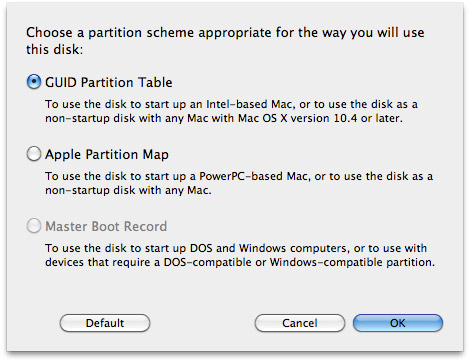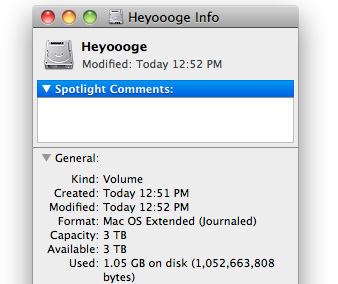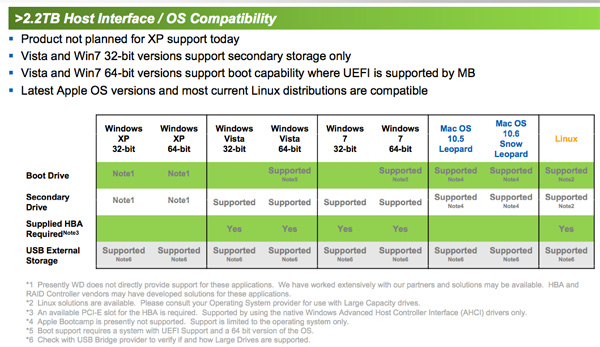Western Digital Caviar Green 3TB and My Book Essential 3TB Drives Reviewed
by Anand Lal Shimpi on October 19, 2010 1:43 PM EST- Posted in
- Storage
- HDDs
- Western Digital
- 3TB
The 2.19TB Barrier
I addressed this in my 3TB Seagate review back in August, so much of this is a rehash from the review back then with some new information toward the end of the page.
Pretty much all HDDs (and SSDs) are addressed using a scheme called Logical Block Addressing (LBA). The method is very, well, logical. Storage is addressed linearly, regardless of how the hardware itself is accessed. You start at LBA 0 and you go all the way up to the last address in your device.
The number of LBAs you can address is a function of your hardware and the style of partition you’ve applied to your drive.
Master Boot Record partitioning is by far the most common on PCs today. LBA 0 contains the Master Boot Record (MBR) and your BIOS looks at the contents of LBA 0 to determine how to boot.
Now LBAs under MBR partitions are addressed using 32-bit values, the maximum of which is 2^32 or 4294967296. Each LBA on a hard drive corresponds to a 512-byte sector value (even on 4K advance format drives, they still appear as 512-byte sector drives to the OS), so the largest partition you can have in a MBR partitioned drive is 4294967296 * 512-bytes or 2,199,023,255,552 bytes.
Hard drive manufacturers define 1TB as 1 trillion bytes. If we use that definition then the largest 32-bit MBR partition would be 2.199TB (2,199,023,255,552 bytes / 1,000,000,000,000). If we define 1TB as 1024^4 bytes (TiB) then the largest 32-bit MBR partition would be 2TiB (2,199,023,255,552 bytes / 1,099,511,627,776). Either way, with a 3TB drive there’s no way we’re getting a single 3TB partition using MBR.
In use on all Itanium and Intel based Macs (among other systems) is GPT (GUID Partition Table), and a feature of GPT is 64-bit LBA support.
With 64-bit LBAs the largest 512-byte sector drive we can address is 9.4ZB (Zettabytes - 10^21 or 2^70 bytes depending on if you’re counting in base 10 or 2). That’s an absurd amount of data.
GPT drives are supported as data drives in all x64 versions of Windows as well as Mac OS X and Linux. Below we have some screenshots of creating a GPT drive in Windows and OS X:

GPT Partition in Windows 7

GPT in Mac OS X
You’ll note that I said data and not boot drives. In order to boot to a GPT partition, you need hardware support. I just mentioned that your PC’s BIOS looks at LBA 0 for the MBR. Your BIOS does not support booting to GPT drives. GPT is however supported by systems that implement the successor to the BIOS: Intel’s Extensible Firmware Interface (EFI).
Intel based Macs don’t use a BIOS and instead have an EFI which allows them to boot to GPT drives. Most PC motherboards however do not have EFI support, and those that do may have bugs associated with the implementation.
I’m expecting to see the first round of motherboards with official 3TB HDD support in the coming weeks. Although consumers shouldn’t expect good support from motherboard makers until the first half of next year. Users of older boards may be out of luck as enabling EFI is still a low priority for most manufacturers.
BIOS support is only part of the problem. You SATA controller also needs to support 64-bit LBAs. Currently Intel’s storage drivers don’t support 64-bit LBAs. Running your ICH in Native IDE mode will work however.
AMD’s 8-series storage drivers do support 64-bit LBAs but I haven’t seen any AMD motherboards with EFI support.
In order to deal with all of the potential controller issues today, Western Digital bundles all 3TB drives with a HighPoint Rocket 620. The controller supports booting to a 3TB formatted drive if your motherboard has EFI support. But as I just mentioned, proper EFI support is tough to come by.

Western Digital expects that we’ll see both motherboard and storage controller support by Q2 2011, at which point it will stop shipping the HighPoint cards with 3TB drives.
The HighPoint adapter uses a Marvell 88SE9025 6Gbps SATA controller, although for some reason installing HighPoint’s drivers on the card (both at boot and under Windows) would cause the drive to disappear entirely. I had to rely on the drivers that ship with Windows 7.
Mac & Linux Support
Intel Macs already ship with EFI support so these drives should just work in a Mac. I popped one into a Nehalem Mac Pro and I confirmed it worked:

Linux is also covered if your distribution enables support for 64-bit LBAs. The full compatibility matrix is below:











48 Comments
View All Comments
Photo-Nerd - Sunday, October 24, 2010 - link
It was slooooooooowwwwww, but on top of that, disk utility was reporting a smart failure.This drive equals the suck.
Boooooo
piroroadkill - Monday, October 25, 2010 - link
You mean that now and then you get failures of <any product name here>?Colour me shocked.
pesos - Saturday, December 18, 2010 - link
Hi Anand, I bought a mybook 3tb usb3 drive with the intention of using it to store Hyper-V VHD virtual disk files.Hyper-V is reporting that it cannot use drives with 4k sector sizes (way to go, microsoft). I have heard that the built-in WSB (same engine used for win7 backups) also has this limitation.
Do you know if there is any way to get 512b emulation on the MyBook drives, or do I need to return this drive and go with a different solution?
Thanks,
Wes
Azaloom - Monday, January 10, 2011 - link
That bundled PCIe-card really looks like a 4-port card. Maybe that's why the HighPoint’s drivers won't work - they have altered the card a little bit and removed port 3 and 4 plugs as excessive? But the solder bases looks to be there on the circuit board. I wonder if you could make it into a 4 four port SATA card just by soldering the missing SATA data-ports to their bases on the board. I mean I already thought about bying this HDD because I have all the SATA ports in use on my MB, and this would give the possibility of adding not one but two more HDD's - who knows, it that's four with a little tweaking. One PCIe lane should be more than enough to drive 4 mainstream HDD's for the average user.coyote2 - Tuesday, February 8, 2011 - link
If a 3TB drive is only formatted to < 2.19TB, would that remove all complications of booting from it?(Odd question, I know. But I'm buying a new system, for which I already own a boot drive I want to reinstall the OS onto; but the system builder requires that I buy the new system with the OS [Windows 7 Pro 64-bit] pre-installed; I'm just wondering if they only format a 3TB hdd to < 2.19TB, will booting from it will be issue-free?)
eazmichael - Tuesday, March 1, 2011 - link
Is WD using the same HD model in the 3TB My book as the internal package? The stand-alone drive costs around $215 or more while the 3 TB My book is now available for less than $180. i was thinking about putting two of the drives in a Synology DS211+ enclosure (Raid 1) - it looks a bit like it is cheaper to buy two My Books and rip the drives out.burbello - Monday, June 30, 2014 - link
Does anybody know if it is possible to replace the hard disk of Western Digital 640GB My Book for a new one with 3TB ? When replacing only the disk, should I perform any particular step? Thank you.burbello - Monday, June 30, 2014 - link
I have an Western Digital 640GB My Book, I would like to replace the hard disk to another WD 3TB, but I am not sure if it will work, does anybody know if this is compatible or even if I have to perform any additional step? Thank you